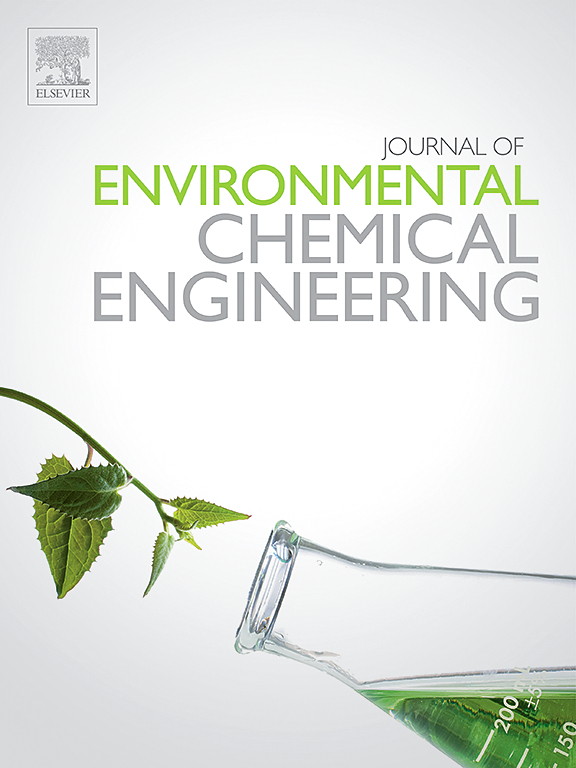将光fenton -like Fe3O4/CdS-O模块集成到海绵基凝胶太阳能蒸发器中,协同水再生和污染物降解
IF 7.4
2区 工程技术
Q1 ENGINEERING, CHEMICAL
引用次数: 0
摘要
解决淡水短缺和消除污染的双重挑战需要创新技术,合理整合多种功能。本研究将光热Fe₃O₄纳米球与氧掺杂CdS (CdS-O)耦合在海绵基水凝胶基质中,开发了具有代表性的双功能太阳能蒸发器,实现了高效的太阳能驱动水再生和污染物降解。该设计利用了两种独特成分的独特作用,其中Fe₃O₄赋予蒸发器宽带太阳能吸收(300-800 nm)和80% %的卓越光热转换效率,而氧掺杂CdS-O缩小其带隙(从2.31 eV到2.29 eV),增强可见光收集和电荷分离。关键是,Fe₃O₄和CdS-O之间的协同相互作用建立了一种自维持的光- fenton -like机制。CdS-O通过光生电子还原O₂生成H₂O₂,Fe₃O₄作为电子受体加速Fe3 +/Fe2+循环,Fe2⁺与H₂O₂通过类芬顿反应生成·OH自由基,实现污染物矿化。同时,水凝胶-海绵结构确保了快速的水分输送和局部热约束,使1次太阳照射下的蒸发速率为1.55 kg·m−2·h−1。该系统具有显著的双重功能:240 分钟内四环素在湖水中的降解率为86.9% %,6个循环后光催化活性保持率为89 %。这项工作通过将光热蒸发和光催化氧化统一到一个可扩展的平台,克服了传统单一功能系统的局限性,通过材料协同和节能设计,为同时生产和净化水提供了可持续的解决方案。本文章由计算机程序翻译,如有差异,请以英文原文为准。
Integrating photo-Fenton-like Fe3O4/CdS-O modules into sponge-based gel solar evaporator for synergistic water regeneration and pollutant degradation
Addressing the dual challenges of freshwater scarcity and pollution elimination requires innovative technologies that rationally integrate multiple functions. This study developed a representative dual-functional solar evaporator by coupling photothermal Fe₃O₄ nanospheres with oxygen-doped CdS (CdS-O) within a sponge-based hydrogel matrix, achieving concurrent high-efficiency solar-driven water regeneration and pollutant degradation. The design leverages the unique roles of two unique components, wherein, Fe₃O₄ endows the evaporator with broadband solar absorption (300–800 nm) and an superior photothermal conversion efficiency of 80 %, while oxygen doping CdS-O narrows its bandgap (from 2.31 eV to 2.29 eV), enhancing visible-light harvesting and charge separation. Crucially, the synergistic interplay between Fe₃O₄ and CdS-O establishes a self-sustained photo-Fenton-like mechanism. CdS-O generates H₂O₂ via photogenerated electron reduction of O₂, and Fe₃O₄ acts as an electron acceptor to accelerate Fe3 +/Fe2+ cycling, Fe²⁺ ions react with H₂O₂ via a Fenton-like process to produce ·OH radicals for pollutant mineralization. Simultaneously, the hydrogel-sponge architecture ensures rapid water transport and localized heat confinement, enabling an evaporation rate of 1.55 kg·m−2·h−1 under 1 sun irradiation. The system demonstrates remarkable dual-functionality: 86.9 % tetracycline degradation in lake water within 240 minutes and 89 % photocatalytic activity retention after six cycles. This work overcomes the limitations of conventional single-function systems by unifying photothermal evaporation and photocatalytic oxidation into a scalable platform, offering a sustainable solution for simultaneous water production and purification through material synergy and energy-efficient design.
求助全文
通过发布文献求助,成功后即可免费获取论文全文。
去求助
来源期刊

Journal of Environmental Chemical Engineering
Environmental Science-Pollution
CiteScore
11.40
自引率
6.50%
发文量
2017
审稿时长
27 days
期刊介绍:
The Journal of Environmental Chemical Engineering (JECE) serves as a platform for the dissemination of original and innovative research focusing on the advancement of environmentally-friendly, sustainable technologies. JECE emphasizes the transition towards a carbon-neutral circular economy and a self-sufficient bio-based economy. Topics covered include soil, water, wastewater, and air decontamination; pollution monitoring, prevention, and control; advanced analytics, sensors, impact and risk assessment methodologies in environmental chemical engineering; resource recovery (water, nutrients, materials, energy); industrial ecology; valorization of waste streams; waste management (including e-waste); climate-water-energy-food nexus; novel materials for environmental, chemical, and energy applications; sustainability and environmental safety; water digitalization, water data science, and machine learning; process integration and intensification; recent developments in green chemistry for synthesis, catalysis, and energy; and original research on contaminants of emerging concern, persistent chemicals, and priority substances, including microplastics, nanoplastics, nanomaterials, micropollutants, antimicrobial resistance genes, and emerging pathogens (viruses, bacteria, parasites) of environmental significance.
 求助内容:
求助内容: 应助结果提醒方式:
应助结果提醒方式:


